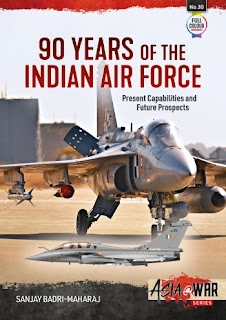This is a new book by Sanjay Badri-Maharaj on the Indian Air Force, published by Helion. The title implies that this is a historical look back over the years since the Indian Air Force was created in 1932. However, while it does provide some historical background, it is primarily a study of the Indian Air Force today.
The Indian Air Force was created on 8 October 1932, and the first squadron was formed in April 1933 of Westland Waptis biplanes. The historical chapter covers the expansion of the force during WW2 and the post-war jet age. Most of the post-war aircraft came from Britain, France and later the USSR, but establishing a domestic aviation industry was always a high priority. This started with a basic trainer and developed into combat aircraft, initially building under license and then developing their own designs. This didn't always go well, but that is not unique to India.The force took part in three wars against Pakistan in 1948, 1965 and 1971, and several proxy campaigns usually involving disputes over Kashmir, like the Kargil War of 1999. In more recent years, China has been seen as a significant threat, and India's doctrine assumes it will be able to fight an aggressive war against Pakistan and a defensive war against China. Performance in these conflicts varied, and the air force's aircraft were often outdated. Notably the use of MiG-21s long after they were in front-line service elsewhere. As late as the Kargil War, strike operations still relied on unguided munitions.
Most of the book focuses on the current state of the Indian Air Force. It is the world's fourth-largest air force with 12,000 officers and 140,000 other ranks, flying over 1500 aircraft. It has 31 combat squadrons, marginally down on the peak of 39.5 squadrons, but many of those were flying outdated aircraft. 13 squadrons of interceptors are reliant on Su-30s, plus three squadrons each of MiG-29s and Mirage 2000s. In addition, four squadrons of MiG-21s will serve until 2024. Two squadrons of Dassault Rafale are probably the most potent fighter in the inventory. For strike aircraft, the MiG-27s are being phased out, leaving upgraded Jaguars as the primary aircraft for some time. They also have a wide range of transport aircraft (250) and helicopters (400), including the Indian-built Dhruv.
The remaining chapters discuss how the air force is likely to be modernised, including developing an indigenous fighter, the Tejas. It also describes the extensive ground-based air defence system and India's nuclear weapons. India also has a space program that can launch and intercept satellites.
This region's actual and potential conflicts are not seen often on the wargame table. I plan to extend my Indo-Pakistan wars forces to the present day, and air combat should be part of that. This book gives all the information you need and is profusely illustrated, including colour plates of the leading aircraft types.

AirForces Monthly magazine often has articles which may be of interest (my interest usually being piqued by the more obscure conflicts which may not gain much mainstream publication - Sri Lanka’s struggles against the Tamil Tigers, for example). You might wanna check to see if they have done anything on the Indians or Pakistanis.
ReplyDeleteCheers,
Geoff
Thanks, I will. I occasionally glance at it in Smiths.
Delete